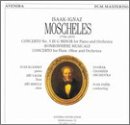| All Artists: Ignaz Moscheles, Ivan Parik, Dvorák Chamber Orchestra Title: Isaak-Ignaz Moscheles: Concerto No. 3 for Piano & Orchestra; Bonbonnière Musicale; Concerto Members Wishing: 0 Total Copies: 0 Label: Avenira Release Date: 7/25/2000 Album Type: Import Genre: Classical Styles: Chamber Music, Forms & Genres, Concertos, Historical Periods, Classical (c.1770-1830), Instruments, Keyboard Number of Discs: 1 SwapaCD Credits: 1 UPC: 675754228828 |
Search - Ignaz Moscheles, Ivan Parik, Dvorák Chamber Orchestra :: Isaak-Ignaz Moscheles: Concerto No. 3 for Piano & Orchestra; Bonbonnière Musicale; Concerto
 | Ignaz Moscheles, Ivan Parik, Dvorák Chamber Orchestra Isaak-Ignaz Moscheles: Concerto No. 3 for Piano & Orchestra; Bonbonnière Musicale; Concerto Genre: Classical
|
Larger Image |
CD Details |
CD ReviewsA pre-romantic gem Timmy | New York, Ny United States | 06/08/2001 (4 out of 5 stars) "Of all the eras in the history of classical music, it is the pre-romantic which lies forgotten. Many a brilliant work has been left untouched in the halls of time: works by Hummel, John FIeld, Spohr, and of course, the estimable Ignaz Moscheles. Born in Bohemia in 1794, Moscheles was one of the most respected composers of his day; even the great Beethoven asked him to write the four-hand piano arrangement of the overture to his opera Fidelio. He was an eminant virtuoso who was trained in the style of Mozart's arch-rival Muzio Clementi. Unlike many of the popular composers of his day, however, Moscheles attempted to synthesize his great virtuosity with profound musical thought. In fact, of all the pre-romantics, it was he who infused his music with the most romantisicm. His work led dirctly into the romantic era. in addition, he was Mendelssohn's teacher and greatly admired by Chopin. Alas, today his work is wholly neglected. The g-minor piano concerto was the last of his works to hold on, disappearing from the active repertoire around 1900. But what a splendid work it is! The first movement is a declaration of anguish, declared of course, in a somewhat restrained manner. Interspersed between these painful cries are short reprieves; the sighs of this elegant composer. This emotion is conveyed in an extremely virtuosic manner. The coda is absolutely marvelous: as the dissonance increases, the quiet dynamics explode and the piano bangs angrily. The slow movement, being extremely meditative and melodic is also worthy of note. The bonbonierre musicale did not please me very much. it is comprised of short salon pieces without much depth. The concerto for flute and oboe,however, was extremely interesting to listen to. Written one year before the composer's death in 1870, it is perhaps his most modern work. It fascinating to listen to the way in which he assimilated the romantic language (he was not entirely successful). In any case, this is an excellent CD, with impassioned playing from both soloists and orchestra. You should definetely buy, along with some works by johann Hepomuk Hummel and John Field, of course!"
|

 Track Listings (12) - Disc #1
Track Listings (12) - Disc #1